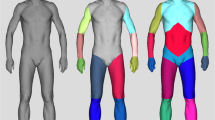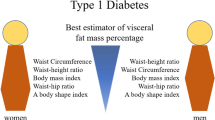Abstract
BACKGROUND: Abdominal adiposity has been described as an independent risk factor for coronary heart disease. Sagittal abdominal diameter has been found to be closely related to the amount of visceral adipose tissue.
AIM: To compare the sagittal abdominal diameter with other anthropometric measures regarding their relationships to risk factors for coronary heart disease (CHD).
DESIGN: A study of 885 men and women participating in a health survey.
MEASUREMENTS: Sagittal abdominal diameter, body mass index (BMI), waist and hip circumferences, waist-to-hip ratio, serum concentrations of risk factors for CHD, blood pressure.
RESULTS: In men the sagittal abdominal diameter showed stronger correlations to the CHD risk factors serum cholesterol, low-density lipoprotein (LDL) cholesterol, triglycerides, glucose, insulin, apolipoprotein B (apoB), plasminogen activator inhibitor tissue-type plasminogen activator (t-PA) and lipid-corrected alpha tocopherol, and to systolic and diastolic blood pressures than the other anthropometric measurements. In women, compared with the other anthropometric measurements the sagittal abdominal diameter was more strongly correlated to serum cholesterol, LDL cholesterol, LDL/HDL (high-density lipoprotein), apo B and t-PA, and to systolic and diastolic blood pressure. The sagittal abdominal diameter showed a stronger correlation to ‘total risk’ for cardiovascular disease (+0.66 for men, +0.62 for women), than waist circumference (+0.63 for men, +0.57 for women) and waist-to-hip ratio (+0.61 for men and +0.48 for women; P<0.0001 for all correlations). This diameter was also more strongly correlated to ‘metabolic risk’ (+0.64 for men, +0.59 for women) than waist circumference (+0.60 for men, +0.59 for women) and waist-to-hip ratio (+0.58 for men, +0.52 for women)(P<0.0001 for all correlations). In a regression analysis including the anthropometric measurements and the risk values, the sagittal diameter was the strongest measure of cardiovascular risk in both men and women.
CONCLUSIONS: Among both men and women in this study the sagittal abdominal diameter showed stronger correlations to cardiovascular risk and to other risk factors in the metabolic syndrome than other anthropometric variables such as waist circumference, waist-to hip ratio and BMI.
This is a preview of subscription content, access via your institution
Access options
Subscribe to this journal
Receive 12 print issues and online access
$259.00 per year
only $21.58 per issue
Buy this article
- Purchase on Springer Link
- Instant access to full article PDF
Prices may be subject to local taxes which are calculated during checkout
Similar content being viewed by others
References
Larsson B, Svärdsudd K, Welin L, Wilhelmsen L, Björntorp P, Tibblin G . Abdominal adipose tissue distribution, obesity, and risk of cardiovascular disease and death: 13 year follow up of participants in the study of men born in 1913 Br Med J 1984 288:: 1401–1404.
Lapidus L, Bengtsson C, Larsson B, Pennert K, Rybo E, Sjöström L . Distribution of adipose tissue and risk of cardiovascular disease and death: a 12 year follow up of participants in the population study of women in Gothenburg, Sweden Br Med J 1984 289:: 1257–1261.
Kvist H, Chowdhury B, Grangård U, Tylén U, Sjöström L . Total and visceral adipose-tissue volumes derived from measurements with computed tomography in adult men and women: predicted equations Am J Clin Nutr 1988 48:: 1351–1361.
Havel RJ, Eder HA, Bragdon JH . The determination and chemical composition of ultracentrifugally separated lipoproteins in human serum J Clin Invest 1955 34:: 1345–1353.
Seigler L, Wu WT . Separation of serum high-density lipoprotein for cholesterol determination: ultracentrifugation vs precipitation with sodium phosphotungstate and magnesium chloride Clin Chem 1981 27:: 838–841.
Hjelm M, deVerdier CH . A methodological study of the enzymatic determination of glucose in blood Scand Clin Lab Invest 1963 15:: 415–428.
Wide L, Axen R, Porath J . Radioimmunosorbent assay of proteins, chemical couplings of antibodies to insoluble dextran Immunochemistry 1967 4:: 381.
Eriksson E, Rånby M, Gyzander E, Risberg B . Determination of plasminogen activator inhibitor in plasma using t-PA and a chromogenic single point poly-D-lysine stimulated assay Thromb. Res. 1988 50:: 90–101.
Rånby M, Bergsdorf N, Nilsson T, Mellbring G, Winblad B, Bucht G . Age dependence of tissue plasminogen activator concentrations in plasma, as studied by an improved enzyme-linked immunosorbent assay Clin chem 1986 32:: 2160–2165.
Öhrvall M, Tengblad S, Vessby B . Lower tocopherol serum levels in subjects with abdominal adiposity J Intern Med 1993 234:: 53–60.
Thurnhamn DI, Davies JA, Crump BJ, Situnayake RD, Davis M . The use of different lipids to express serum tocopherol: lipid ratios for the measurement of vitamin E status Ann Clin Biochem 1986 23:: 514–520.
Morrison DF . Multivariate statistical methods McGraw-Hill: New York 1976 pp 176–179.
Han TS, van Leer EM, Seidell JC, Lean MEJ . Waist circumference action levels in the identification of cardiovascular risk factors: prevalence study in a random sample Br Med J 1995 311:: 1401–1405.
Ohlson LO, Larsson B, Svärdsudd K, Welin L, Eriksson H, Wilhelmsen L, Björntorp P, Tibblin G . The influence of body fat distribution on the incidence of diabetes mellitus. 13.5 years of follow-up of the participants in the study of men born in 1913 Diabetes 1985 34:: 1055–1058.
Lean MEJ, Han TS, Seidell JC . Impairment of health and quality of life in people with large waist circumference Lancet 1998 351:: 853–856.
Pouliot MC, Després JP, Lemieux S, Moorjani S, Bouchard C, Tremblay A, Nadeau A, Lupien PJ . Waist circumference and abdominal sagittal diameter: Best simple anthropometric indices of abdominal visceral adipose tissue accumulation and related cardiovascular risk in men and women Am J Cardiol 1994 73:: 460–468.
Després JP, Prud'homme D, Pouliot MC, Tremblay A, Bouchard C . Estimation of deep abdominal adipose-tissue accumulation from simple anthropometric measurements in men Am J Clin Nutr 1991 54:: 471–477.
Richelsen B, Pedersen SB . Associations between different anthropometric measurements of fatness and metabolic risk parameters in non-obese, healthy, middle-aged men Int J Obes 1995 19:: 169–174.
Kumlin L, Dimberg L, Mårin P . Ratio of abdominal sagittal diameter to height is strong indicator of coronary risk (letter) Br Med J 1997 314:: 830.
Ashwell M, Lejeune S, McPehrson K . Ratio of waist circumference to height may be better indicator of need for weight management (letter) Br Med J 1996 312:: 377.
Ashwell M, Cole TJ, Dixon AK . Ratio of waist circumference to height is strong predictor of intra-abdominal fat (letter) Br Med J 1996 313:: 559–560.
Author information
Authors and Affiliations
Corresponding author
Rights and permissions
About this article
Cite this article
Öhrvall, M., Berglund, L. & Vessby, B. Sagittal abdominal diameter compared with other anthropometric measurements in relation to cardiovascular risk. Int J Obes 24, 497–501 (2000). https://doi.org/10.1038/sj.ijo.0801186
Received:
Revised:
Accepted:
Published:
Issue Date:
DOI: https://doi.org/10.1038/sj.ijo.0801186
Keywords
This article is cited by
-
Evaluation of the relationship between abdominal fat distribution and osteoporotic vertebral compression fracture with MRI
Skeletal Radiology (2023)
-
Sagittal abdominal diameter and its socioeconomic correlates: perspective of sex differences
BMC Public Health (2021)
-
Associations between Central Obesity and Outcomes of Adult In-hospital Cardiac Arrest: A Retrospective Cohort Study
Scientific Reports (2020)
-
Radiation Dose Reduction in CT Fluoroscopy-Guided Lumbar Interlaminar Epidural Steroid Injection by Minimizing Preliminary Planning Imaging
European Radiology (2014)
-
The relationships between body composition and cardiovascular risk factors in young Australian men
Nutrition Journal (2013)



